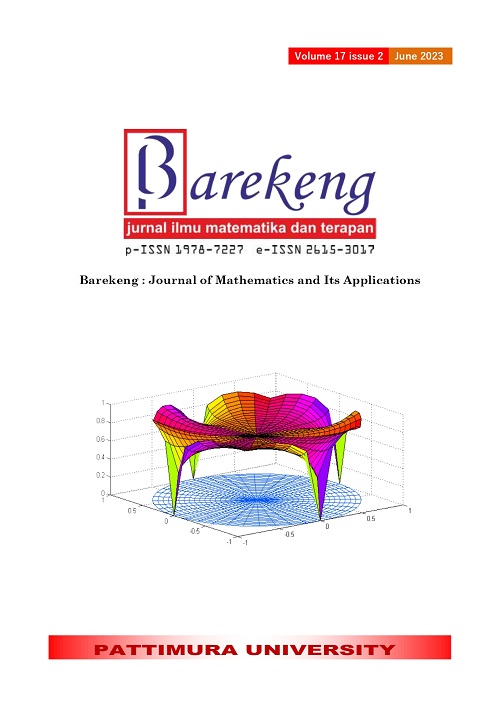MATHEMATICAL MODEL OF RICE COMMODITY SUPPLY CHAIN IN INDONESIA
Abstract
Food is the main need for every individual that must always be fulfilled. For Indonesia, food is identified with rice because this type of food is a commodity consumed by the Indonesian population. Therefore, the rice crisis can be interrupt economic resilience and national stability. National rice consumption from year to year will continue to increase in line with the increase in Indonesia's population. Although, Indonesia is the third-largest country in the world in producing the most, Indonesia still depends on rice imports. This was done by the government to maintain the national rice supply.The rice supply chain in Indonesia has not been optimum, as indicated by the relatively small profits of producer. In this research, we construct the maximum profit model of direct and indirect media sales of rice for producer, distributor, and retailer. And then, we determine the optimum solution of the model and analysis of the factors in the rice supply chain that affect it. The results showed that changes in the proportion of demand greatly affects the resulting optimal profit.
Downloads
References
A. Mahbubi, “Model Dinamis Supply Chain Beras Berkelanjutan Dalam Upaya Ketahanan Pangan Nasional,” Jurnal Manajemen & Bisnis, vol. 10, no. 2, pp. 81–89, Jun. 2013.
S. Chopra and P. Meindl, Supply chain management : strategy, planning, and operation. Pearson, 2013.
W. L. Winston, Operation Research Applications and Algorithms. Pacific Grove: Thomson Brooks/Cole, 2004.
Y. Sarawagi, H. Nakayama, and T. Tanino, Theory Multiobjective Optimization. Waltham: Academic Press, 1985.
B. K. Bala, M. G. K. Bhuiyan, M. M. Alam, F. M. Arshad, S. F. Sidique, and E. F. Alias, “Modelling of Supply Chain of Rice in Bangladesh,” International Journal of Systems Science: Operations & Logistics, vol. 54, no. 2, pp. 181–197, May 2016.
D. Surjasa, E. Gumbira-Sa, B. Arifin, and F. Jie, “Indonesian Rice Supply Chain Analysis and Supplier Selection Model,” International Journal of Information, Business and Management, vol. 5, no. 1, 2013.
Badan Pusat Statistik, “Statistik Indonesia 2019,” Dec. 2019.
H. Nee and A. Yong, “Supply Chain Model For Rice in Malaysia-Basics and Challenges Risk tendency Decision-Making Processes towards Risk Riding Behaviour View project Sustainable supply chain View project,” 2008. [Online]. Available: https://www.researchgate.net/publication/270880670
J. Murti and M. Aji, “Rice Supply Chains in Indonesia: How Do They Work?”
O. South, J. Sumarauw, and M. Karantu, “Analisis Desain Jaringan Supply Chain Komoditas di Desa Karandoran Kecamatan Langowan Timur Kabupaten Minahasa,” Jurnal Riset Ekonomi Manajemen Bisnis da Akuntansi, vol. 5, pp. 511–519, 2017.
V. Sharma, S. Giri, and S. Shankar Rai, “Supply Chain Management Of Rice In India: A Rice Processing Company’s Perspective,” International Journal of Managing Value and Supply Chains, vol. 4, no. 1, pp. 25–36, Mar. 2013, doi: 10.5121/ijmvsc.2013.4103.
N. I. Kurniawati, R. E. Werdani, and S. R. Mege, “Development of Supply Chain Management Models in Rice Production to Improve Food Endurance and Security in Demak Regency,” International Journal of Multicultural and Multireligious Understanding, vol. 7, no. 8, p. 603, Sep. 2020, doi: 10.18415/ijmmu.v7i8.1840.
A. D. Guritno, N. E. Kristanti, and M. R. Tanuputri, “Collaborative Strategy for the Supply Chain of Rice: A Case Study on Demak and Sukoharjo Regency, Central Java, Indonesia,” agriTECH, vol. 41, no. 1, p. 1, Mar. 2021, doi: 10.22146/agritech.48929.
Yuntawati Fristin and Fajar Supanto, “Development Model of Rice Supply Chain Management to Ensure Self-Sufficiency and Food Security,” Jurnal Bisnis dan Manajemen, vol. 8, no. 2, pp. 353–366, 2021.
Wuryantoro, T. Sjah, I. Budastra, C. Ayu, N. L. S. Supartiningsih, and S. Maryati, “Analysis of supply chain and added value of rice in west Lombok regency,” IOP Conference Series: Earth and Environmental Science, vol. 913, no. 1. IOP Publishing Ltd, Dec. 02, 2021. doi: 10.1088/1755-1315/913/1/012034.
Prasetyo Adi Wibowo Putro, Erisvaha Kiki Purwaningsih, Dana Indra Sensuse, Ryan Randy Suryono, and Kautsarina, “Model and Implementation of Rice Supply Chain Management : A Literature Review,” Procedia Comput Sci, vol. 197, pp. 453–460, 2022.
Copyright (c) 2023 Dwitama Alphin Usdianto, Ririn Setiyowati

This work is licensed under a Creative Commons Attribution-ShareAlike 4.0 International License.
Authors who publish with this Journal agree to the following terms:
- Author retain copyright and grant the journal right of first publication with the work simultaneously licensed under a creative commons attribution license that allow others to share the work within an acknowledgement of the work’s authorship and initial publication of this journal.
- Authors are able to enter into separate, additional contractual arrangement for the non-exclusive distribution of the journal’s published version of the work (e.g. acknowledgement of its initial publication in this journal).
- Authors are permitted and encouraged to post their work online (e.g. in institutional repositories or on their websites) prior to and during the submission process, as it can lead to productive exchanges, as well as earlier and greater citation of published works.






1.gif)



